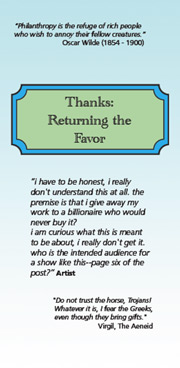  
|
Thanks:
Returning the Favor
Organized by apexart
Artists: Felipe Arturo, Nayia Frangouli,
David Greg Harth, Vandana Jain, Matt Keegan, Kambui Olujimi,
Lisi Raskin, Paul Wirhun, Joe Scanlan, Alejandra Villasmil
November 29 - January 6, 2007
291 Church St. New York, NY 10013
OPENING RECEPTION:
Wednesday November 29, 6-8pm

|

Download BROCHURE
Download PRESS
RELEASE
Download ESSAY
by Phong Bui
Download DOWNTOWN EXPRESS REVIEW
|
|
An Editorial on the
Artist and Society
By Phong Bui
There has always been a great schism between those celebrated
artists who receive extraordinary rewards and those artists
that bring forth major works while struggling, unrecognized,
in miserable poverty. The cause of this discrepancy throughout
history is not entirely inexplicable. Many patrons spend considerably
more money on collecting antiques than on commissioning or
purchasing contemporary works of art. Some simply lack the
discrimination and courage to support unknown artists. Others,
perhaps after bursts of enthusiastic patronage, offer meager
support once their fleeting interest passes. In either case,
it is nearly impossible to decipher those different conditions
without resting on the sole strength of the work of art.
In our own time, we have seen many artists who, having attainted
a certain degree of fame, cease their efforts to create great
work. That is to say, in order to fulfill a desire to remain
in vogue, they attempt to appeal to their collectors or dealers
by repeatedly exploring the same identifiable style. Not to
mention young artists who, while still in graduate school,
adopt an impeccable business-mindedness and create works that
cater to the quick thrill of novelty. (In fact, I’m
vehemently against those corporate policies, implemented by
highly reputed art schools and universities, the so-called
“open studios,” where dealers, curators and collectors
wander freely, commandeering young artists before they can
experience the struggles so necessary to gaining maturity.)
As Willem de Kooning once brilliantly commented, “The
desire to create a single style beforehand is a mere apology
of one’s own anxiety.” We have also witnessed,
however, a handful of great artists who are able to sustain
the inner focus and growth that their work demands, in spite
of fame. Similarly, we are aware of the disproportionately
large number of artists who, in their reluctance to be part
of pervasive critical dialogues—artistic, social and
political—attempt to protect themselves by embodying
the role of “underappreciated genius” as a defense
mechanism. Finally, there are a few who firmly believe—in
keeping with the romantic spirit—that genius thrives
best in poverty. They perceive adversity as the most fertile
atmosphere for generating masterpieces.
Nonetheless, in spite of differing circumstances, we know
for certain that all artists inherently wish to relate to
the aesthetic realm as an autonomous domain, coordinating
their cognitive and moral faculties while performing distinct
roles of their own in the life of the mind.
Let us go back to the end of the 18th century, when the cultural
and intellectual unity established by the Renaissance began
to disintegrate after the French Revolution. For nearly four
hundred years, the given practice of an artist had been that
of standardized apprenticeship with a known master, which
included repeated interpretation of familiar subjects such
as Greek Mythology, The Bible, or, occasionally, historical
events and portraiture. (I am aware that I’m not including
the development of landscape and still life painting in the
17th century, which had a great impact on the genesis of modern
art.) As the aristocracy and the church lose their authority
to the rise of the middle class, the artist’s role diversified,
the work becomes more secular, and subject matter is chosen
from a mutable everyday experience. What was once a static
patronage system—which included the Duke of Urbino,
the de Medicis, the Corsinis and the Vatican—has been
replaced by a new patron-artist relationship which allows
the artist more autonomy, such as Gertrude and Leo Stein,
Claribel and Etta Cone, John Quinn, Walter Arensberg, Katherine
Dreier, Peggy Guggenheim, and in our recent decades, John
and Dominique de Menil, Joseph Pulitzer Jr., etc (Again, I’m
aware that I’m skipping through several centuries, and
forgive me if I leave out many other patrons’ names
due to my short-term memory.) In addition, although the changes
may not seem radically different to some of us, the impact
had inevitably changed with various directions that lie beyond
the artist’s old habits and commitments. Still, there
will always be a division between those who insist on adhering
to preexisting models (creating work that can depend on some
sort of stability) and those who are receptive to the constant
flux of social and aesthetic changes. Just as the Renaissance
invention of perspective and the study of anatomy altered
the course of Western art for nearly five centuries, one dares
to say that Cubism and Surrealism will have the same resonance
for Western art many years to come. Similarly, just as much
as Modernism believed in the big narrative, Post-Modernism
now finds refuge in small and fleeting events of everyday
life. While the Modernists lamented with weighty doubts and
existentially reexamined Western philosophy, the Post-Modernists
are now ready to decentralize that source of thinking. Based
on the new modes of production and technologies that belong
to the third phase of capitalism, Frederic Jameson’s
1984 volume Post-Modernism, or The Cultural Logic of Late
Capitalism, which was considered a classic Marxist analysis,
systematically pointed out the clear break from Modernism:
the rise of a multinational, consumer culture that coincided
with Reagan’s inflated economy, and the quick spread
of globalization in every walk of life. Instead of deriving
its agenda from the study of literature or art history as
Modernism did, Post-Modernism’s main source of focus
stemmed from history and sociology. This is one of the reasons
that no specific style of art or movement has monopolized
the art world since Post-Conceptualism.
In the last two decades we’ve experienced the confidence
of artists coming from Asia, Latin America, the Middle East
and Africa, who don’t feel pressured to simulate and
assimilate to the West’s establishment of aesthetic,
or respond to its art historical lineage. The artists, in
turn, import fragments of their own cultural heritage, sometimes
infusing it with current social and political concerns.
The negative side of this global exchange, as articulated
by the 18th century British poet, Dr. Edward Young, in his
famous aphorism, “Why is it that we’re all born
originals but die as copies?” is that there are too
many impersonal and sentimental off-shoots of artificial readings
in which form and content seemed to be mistaken for sensationalism.
In the same way our culture gets confused about the difference
between knowledge and information, or about lived versus hypothetical
experience. As we become increasingly dependent on standardized
modes of learning, the whole critical discourse of art institutions,
curators, collectors, dealers and critics alike becomes a
predictable homogeneity.
One wonders if such predictable homogeneity will imperil the
artist’s inner sense of freedom and ambition, which
parallels inner as well as outer circumstance. To every artist,
freedom means the inseparable relationship between the individual
and his/her social aspect. While the former yields towards
the unaccountable flow of images and ideas that get transformed
through the movement of hands into an artwork, the latter
is connected to his or her sense of verve and spontaneous
receptiveness to everyday events and social surroundings.
Should practical aims and fixed notions of style, equated
by the artist’s desire for success, be regarded as the
debasement of art in contemporary culture? All we know is
that the polarities are subject to certain changing views
about the relationship of the imaginary and the real—the
“romantic” vision meets the tangible contemporary
reality. This line of questioning is, of course, reminiscent
of the writings of Diderot and Baudelaire, both being intensely
concerned with the nature of art and the role of the artist
in society. For Diderot, the artist is the great model of
the natural, productive, and self-fulfilling individual. By
following an impulse, working from inner necessity, though
guided by an ideal truth, the artist is able to move toward
a gradual perfection, which could only be achieved through
the creative process. Like the poet and thinker, the artist
works in solitude allowing feelings and thought to be brought
into a harmonious unity. Therefore the artist is fully aware
of self-imposed controls and idiosyncratic tendencies, leading
to an ultimate realization of individuality and freedom, which
in turn inspires others. Baudelaire was obsessed with the
idea of the enduring quality of the art of his time. He believed
that for a work of art to attain a permanent, eternal element
which belongs to all time, it must express the actuality of
something felt of the moment. It is only then that the criteria
for the universal and the particular are negotiable. Not only
can the artist bring forth a synthesis of verve and judgment—a
fusion of the inspired and the rational—but the artist’s
autonomy will be protected, thereby reaching the moral conscience
of the art viewing public.
In the Salon of 1845 Baudelaire attacked the Bourgeoisie,
yet in the Salon of the following year, he dedicated his homage
to them, and declared that artists must depend on the Bourgeoisie
because they possess a certain civic virtue. Here I will leave
you with de Kooning’s witty remark, “For milk
to become yoghurt, it needs culture.”
Phong Bui is an artist and the publisher
of the monthly journal The Brooklyn Rail |
|
|

